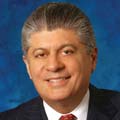
Then, she argued that hate speech and incendiary speech should be prosecuted. Finally, she attacked the U.S. Supreme Court, which is about to rule on a challenge to New York's restrictive concealed carry laws. She said twice that "New York is ready for you." It is unclear just what she meant, but the implication was that she'd find a way around whatever the court rules.
She uttered a bitter constitutional mouthful.
From the writings and mental history of the gunman, we know that he was and is deeply disturbed. Police brought him to a mental hospital after he made threats at school, and his hatreds were posted on dark websites. Nevertheless, New York gun laws — among the strictest in the country — did not stop him from lawfully purchasing a rifle and the ammunition with which to use it.
The gun control crowd, personified by the governor, makes critical errors in its arguments and shows material misunderstandings of fundamental liberties.
Its critical error is a mistaken belief that someone willing to commit mass murder will somehow comply with gun regulations. It doesn't matter to the killer what the gun laws are; he will find a way to attempt to kill. What matters is a set of laws with which law-abiding folks do comply, the effect of which is to neuter their ability to defend themselves.
This column has steadfastly maintained that the only language mass murderers respect is their own — violence. Only violence against them, or its serious imminent threat, will stop them.
Hence, contrary to the New York governor and the laws she likes, only an armed citizenry will give the creeps among us pause before killing, and only superior fire power will stop them once they start. Their hatred of their intended victims is beyond reason and beyond the ability of the law to regulate. They don't know and couldn't care what the laws are. They only react to fear and their own bloodshed.
John Lott, who is the country's foremost gatherer and analyst of gun statistics, has demonstrated conclusively that more guns equals fewer crimes of violence. The killers themselves have recognized this, as they only stop when confronted by superior firepower.
All of this is an argument from reason and common sense.
The argument from the Constitution recognizes the right to self-defense as a fundamental liberty. It is in the highest category of rights we have. The Supreme Court has made it clear that the right to keep and bear arms is the modern extension of the ancient, natural and common law right to self-defense.
The court has yet to rule on the circumstances under which one may exercise this right outside one's home. But to the framers, because it was a natural right, it traveled with you. The governor of New York apparently fears the recognition of this traveling right. She shouldn't. Her state-employed bodyguards exercise it 24/7 for her benefit.
Her comments about free speech are just plain wrong under contemporary Supreme Court jurisprudence, and they are dangerous because they can constitute chilling. Chilling is any behavior by the government that tends to show displeasure or that appears to offer resistance to the exercise of the freedom of speech. Chilling often gives one second thoughts before speaking for fear of a government reprisal. The Supreme Court has defined chilling as a direct violation of the First Amendment and thus as unconstitutional.
The court has ruled that hate speech and incendiary speech are protected. We all know that both of these types of speech can sting and the hurt can persist. But the remedy for them is not to silence the speaker or to blame the owner of the bulletin board for the message that he permits to be posted. The remedy for hate speech and incendiary speech is more speech.
The leading case is a 1969 Supreme Court opinion called Brandenburg v. Ohio. In that case, a Ku Klux Klan leader in Hamilton County, Ohio, condemned Jews and Blacks and incited a crowd to march to Washington to take back the government; "revengeance" — a made up word — is what he called for. His absurd argument caught the attention of Ohio prosecutors who charged him with incitement to riot. He was convicted, and the conviction was upheld by the Ohio Supreme Court.
In a groundbreaking unanimous ruling, the U.S. Supreme Court reversed his conviction. In so doing, it gave us a modern summary of the limits of incendiary and hateful speech. From and after Brandenburg, all innocuous speech is absolutely protected; and all speech is innocuous when there is time for more speech to challenge it. The values underlying the First Amendment speech and press clauses mandate that all doubt and all inferences favor the speech and disfavor government regulation of it.
The amendment presumes that folks can decide for themselves what to hear and read and how to respond, and this process of the give and take of ideas must be devoid of government involvement. Speech is not only the utilization of the natural rights to think as you wish and say what you think and publish what you say; it is, the courts have ruled, vital to democratic values that all persons remain free to speak their minds, no matter how caustic or hateful are their ideas.
The governor has blinders on. She complains of too much freedom. In New York, there is too little.
(COMMENT, PLEASE, BELOW)
Andrew P. Napolitano, a former judge of the Superior Court of New Jersey, was the senior judicial analyst at Fox News Channel. Judge Napolitano has written seven books on the U.S. Constitution.


 Contact The Editor
Contact The Editor
 Articles By This Author
Articles By This Author